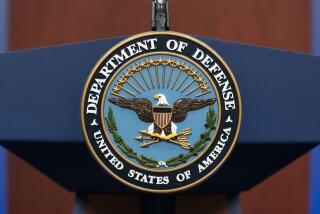Iraq Bolsters Its Defenses, Pentagon Says : Military: A 2nd line of trenches is reported behind the front. Troop strength grows to 510,000.
- Share via
WASHINGTON — Iraqi President Saddam Hussein, spurning repeated warnings to withdraw his forces from Kuwait, has continued to increase the size of his military deployment and to bolster his lines of defense with new fortifications, the Pentagon said Tuesday.
Despite persistent reports that Hussein might seek to defuse the crisis by undertaking a partial withdrawal before the Jan. 15 deadline, Iraqi troops facing U.S. and allied forces have grown almost 15% since the end of November and currently number 510,000, Pentagon spokesman Pete Williams said. The Iraqis have dug a second line of trenches, tank traps and fortifications a few miles behind an already elaborate network of defenses.
Secretary of State James A. Baker III warned Monday of a possible strategy by Hussein to withdraw from part of Kuwait and retain the rest, but Williams said the recent troop movements do not appear designed to accomplish that goal.
Secretary of Defense Dick Cheney said Baker’s statement was merely speculative and that all the evidence on the ground indicates that Iraq plans to hold on to all the territory it has conquered and occupied.
Cheney asserted once again that the Bush Administration rejects any Iraqi move short of complete retreat from Kuwait, which it annexed after a quick armored assault on Aug. 2.
“The guy has got over 500,000 troops, some 4,000 tanks in Kuwait and southern Iraq,” Cheney said en route to Saudi Arabia, where he will meet with U.S. and allied commanders for briefings on military readiness for offensive action after Jan 15.
“He (Hussein) might move the pieces around on the board, but our objective is for him to get all of that stuff out of Kuwait--not half of it, not 75%, not 10%. All of it,” the defense secretary declared.
The growth of Iraq’s forces in and around Kuwait comes three weeks after Hussein announced plans to nearly double his military deployment by mobilizing additional reservists for duty.
The Pentagon later cited indications that Iraqi troops were being transferred to the Kuwaiti theater from Iraq’s border with Iran. But they discounted the significance of the reserve deployment, arguing that the reinforcements probably are poorly trained and equipped.
While almost 60,000 additional Iraqi troops have poured into the area, Williams noted that the number of Iraqi tanks, armored personnel carriers and artillery pieces remains unchanged at 4,000 tanks, 2,700 artillery pieces and 2,500 infantry vehicles and armored personnel carriers.
At the same time, the United States is in the early stages of its own second-wave deployment. A total of 270,000 U.S. troops now are in and around Saudi Arabia, with as many as another 130,000 en route to the region.
Cheney said that the American military force in the region will not be fully ready to launch an all-out war on Iraq on Jan. 15. The Administration announced last month that is was reinforcing the force in the gulf to bring total strength to more than 400,000 troops in preparation for the possibility of war in mid-January.
The bulk of the forces and equipment will be on the ground and at sea in the area by then, the defense secretary said, but training, logistic support and command networks will not be fully developed.
“I think most of the force will be there by then, but obviously there’s additional work to be done before you would identify them as combat-ready,” Cheney said.
Gen. Colin L. Powell, chairman of the Joint Chiefs of Staff, who is traveling with Cheney, said U.S. war plans call for a phased attack on Iraqi forces in Kuwait and southern Iraq.
He would not detail the timing or sequence of the attacks, but other senior military officials have indicated that the United States would launch a massive air campaign before initiating any ground offensive.
“We’re looking at an air, land and sea campaign . . . but it doesn’t mean we’re going to do it all at once,” Powell said. “I’m not going to tell you the sequence or what the timing of that sequence would be. I want him (Hussein) to sit there in beautiful downtown Baghdad and worry his butt off about it.”
Pentagon officials have said that the latest round of deployments, which include the movement of thousands of troops and weapons from Western Europe, have been delayed by snowstorms in Europe and other logistic problems.
As the U.N. deadline approaches, the difficulty of moving troops and equipment into place on time could force the Administration either to delay its response or to initiate an attack against Iraqi troops before its forces are fully in place.
Healy reported from Washington and Broder while en route to Saudi Arabia.
More to Read
Sign up for Essential California
The most important California stories and recommendations in your inbox every morning.
You may occasionally receive promotional content from the Los Angeles Times.











